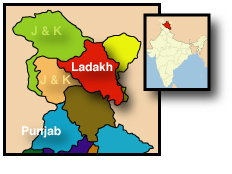Monasteries of Ladakh
Monasteries of Ladakh
Ladakh is famous all over the world for its Monasteries and Gompas. Since the advent of Buddhism perhaps around 100 AD or so a number of Monasteries and Gompas have been built here. These Gompas are not only great religious centres of Ladakh but they are great centres of culture as well. Ladakh Cultural life seems to revolve round the holy precints of these monasteries. The fame of these Gompas has spread far and wide. They command a unique architectural style which is so peculier to Ladakh given its local ecology and building material available. These Gompas not only preserve the rich cultural traditions like the masked dance of Buddhist Monks but have been repositories of a great painting school which has been influenced by Kashmir. The scrolls Thankas, and mural paintings of these Gompas are a treat to watch. No wonder that the largest Gompa of Ladakh-Hemis has been listed as a world heritage site by UNESCO.
- from Dictionary.com
- Monastery - c.1420 (implied in monasterical), from O.Fr. monastere, from L.L. monasterium, from Late Gk. monasterion "a monastery," from monazein "to live alone," from monos "alone" (see mono-). With suffix -terion "place for (doing something)." Originally applied to houses of any religious order, male or female.
- Gompa from wikipedia.com
- Gompas are Buddhist temples (typically forming monasteries or nunneries, Sanskrit name vihara), located in Tibet, Ladakh (India), Nepal, and Bhutan. Their design and interior details vary from region to region, however, all follow a general layout of a central prayer hall containing a Buddha statue, benches for the monks or nuns to engage in prayer or meditation and attached living accommodations.

